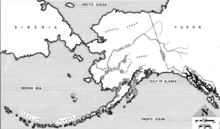
Back الاستعمار الروسي للأمريكيتين Arabic Ruská kolonizace Ameriky Czech Ρωσικός αποικισμός της Αμερικής Greek Rusia koloniigo de Ameriko EO Colonización rusa de América Spanish Colonisation russe de l'Amérique French Kolonisasi Amerika oleh Rusia ID Colonizzazione russa dell'America Italian ロシアによるアメリカ大陸の植民地化 Japanese വടക്കേ അമേരിക്കയിലെ റഷ്യൻ കോളനിവൽക്കരണം Malayalam
| Russian America Русская Америка Russkaya Amerika | |||||||||
|---|---|---|---|---|---|---|---|---|---|
| Colony of the Russian Empire | |||||||||
| 1741–1867 | |||||||||
 Russian Creole settlements | |||||||||
 Russian possessions in North America (1835) | |||||||||
| Anthem | |||||||||
| "Боже, Царя храни!" Bozhe Tsarya khrani! (1833–1867) ("God Save the Tsar!") | |||||||||
| Capital |
| ||||||||
| Demonym | Alaskan Creole | ||||||||
| Area | |||||||||
| • Coordinates | 57°03′N 135°19′W / 57.050°N 135.317°W | ||||||||
| Government | |||||||||
| • Type | Monarchy | ||||||||
| Governor | |||||||||
• 1799–1818 (first) | Alexander Baranov | ||||||||
• 1863–1867 (last) | Dmitry Maksutov | ||||||||
| History | |||||||||
| 15 July 1741 | |||||||||
| 18 October 1867 | |||||||||
| |||||||||
| Today part of | United States | ||||||||
| Part of a series on the |
| History of Alaska |
|---|
 |
|
From 1732 to 1867, the Russian Empire laid claim to northern Pacific Coast territories in the Americas. Russian colonial possessions in the Americas were collectively known as Russian America (Russian: Русская Америка, romanized: Russkaya Amerika; 1799 to 1867). It consisted mostly of present-day Alaska in the United States, but also included the outpost of Fort Ross in California. Russian Creole settlements were concentrated in Alaska, including the capital, New Archangel (Novo-Arkhangelsk), which is now Sitka.
Russian expansion eastward began in 1552, and in 1639 Russian explorers reached the Pacific Ocean. In 1725, Emperor Peter the Great ordered navigator Vitus Bering to explore the North Pacific for potential colonization. The Russians were primarily interested in the abundance of fur-bearing mammals on Alaska's coast, as stocks had been depleted by overhunting in Siberia. Bering's first voyage was foiled by thick fog and ice, but in 1741 a second voyage by Bering and Aleksei Chirikov made sight of the North American mainland. Bering claimed the Alaskan country for the Russian Empire.[1] Russia later confirmed its rule over the territory with the Ukase of 1799 which established the southern border of Russian America along the 55th parallel north.[2] The decree also provided monopolistic privileges to the state-sponsored Russian-American Company (RAC) and established the Russian Orthodox Church in Alaska.
Russian promyshlenniki (trappers and hunters) quickly developed the maritime fur trade, which instigated several conflicts between the Aleuts and Russians in the 1760s. The fur trade proved to be a lucrative enterprise, capturing the attention of other European nations. In response to potential competitors, the Russians extended their claims eastward from the Commander Islands to the shores of Alaska. In 1784, with encouragement from Empress Catherine the Great, explorer Grigory Shelekhov founded Russia's first permanent settlement in Alaska at Three Saints Bay. Ten years later, the first group of Orthodox Christian missionaries began to arrive, evangelizing thousands of Native Americans, many of whose descendants continue to maintain the religion.[3] By the late 1780s, trade relations had opened with the Tlingits, and in 1799 the RAC was formed in order to monopolize the fur trade, also serving as an imperialist vehicle for the Russification of Alaska Natives.
Angered by encroachment on their land and other grievances, the indigenous peoples' relations with the Russians deteriorated. In 1802, Tlingit warriors destroyed several Russian settlements, most notably Redoubt Saint Michael (Old Sitka), leaving New Russia as the only remaining outpost on mainland Alaska. This failed to expel the Russians, who re-established their presence two years later following the Battle of Sitka. (Peace negotiations between the Russians and Native Americans would later establish a modus vivendi, a situation that, with few interruptions, lasted for the duration of Russian presence in Alaska.) In 1808, Redoubt Saint Michael was rebuilt as New Archangel and became the capital of Russian America after the previous colonial headquarters were moved from Kodiak. A year later, the RAC began expanding its operations to more abundant sea otter grounds in Northern California, where Fort Ross was built in 1812.
By the middle of the 19th century, profits from Russia's North American colonies were in steep decline. Competition with the British Hudson's Bay Company had brought the sea otter to near extinction, while the population of bears, wolves, and foxes on land was also nearing depletion. Faced with the reality of periodic Native American revolts, the political ramifications of the Crimean War, and unable to fully colonize the Americas to their satisfaction, the Russians concluded that their North American colonies were too expensive to retain. Eager to release themselves of the burden, the Russians sold Fort Ross in 1841, and in 1867, after less than a month of negotiations, the United States accepted Emperor Alexander II's offer to sell Alaska. The Alaska Purchase for $7.2 million (equivalent to $157 million in 2023) ended Imperial Russia's colonial presence in the Americas.
- ^ Charles P. Wohlforth (2011). Alaska For Dummies. John Wiley & Sons. p. 18.
- ^ United Kingdom of Great Britain and Ireland, "Text of Ukase of 1779" in Behring Sea Arbitration (London: Harrison and Sons, 1893), pp. 25–27
- ^ Sergei, Kan (2014). Memory Eternal: Tlingit Culture and Russian Orthodox Christianity Through Two Centuries. Seattle: University of Washington Press. ISBN 9780295805344. OCLC 901270092.

